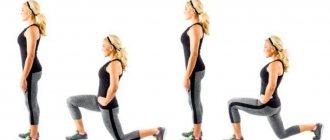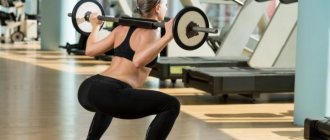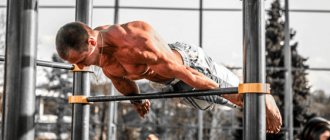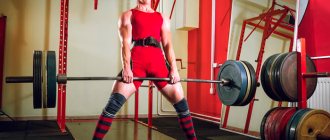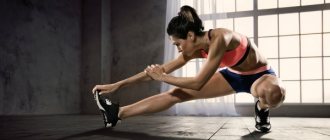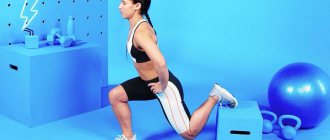The benefits of lunges
The popularity of the exercise is due to many advantages:
- Development of power characteristics . Lunges with additional weights are used in strength training as a way to specifically target the hips.
- Relief improvement . Quick lunges with your own weight or minimal loads help to achieve high-quality “detailing” of the leg muscles.
- Development of coordination . Thanks to the simultaneous development of several stabilizer muscles, the athlete improves his sense of balance and dexterity.
- Strengthening problem areas . Girls use lunges to work their inner thighs, improving the appearance of their legs.
- Losing weight . The exercise simultaneously uses large muscles of the body, which forces the body to spend a large number of calories to provide energy.
- Butt training . By changing the exercise technique, an athlete can shift the emphasis of the load from the hips to the buttocks, achieving an increase in their volume.
- Stretching . Thanks to deep lunges in different directions, the athlete gets the opportunity to improve leg stretching and hip joint mobility.
In addition to the above, classic lunges with your own weight can be an excellent replacement for squats with a barbell if you have problems with the spine.
What are back lunges?
Backward leg lunges are included in the training program of those who want to work the thighs and buttocks. They allow you to use several muscle groups at once, improve coordination, strength and flexibility. The main objective of this exercise is to form the relief of the buttocks and hips and improve their shape.
It is important to understand the difference between forward lunges and backward lunges. Unlike classic lunges, with a reverse variation the working leg is motionless, and the step is performed with the supporting leg. This movement helps reduce the load on the knee joints of the active leg. This exercise can be useful for those who have suffered knee injuries or problems with them, and people who do step aerobics, since their knee joints already receive a lot of stress. Despite the fact that lunges with a step back are considered easier than classic ones, they are included in the most effective exercises for the hips and buttocks, since the muscles are still worked very well when performing them. And to improve performance, it is recommended to combine forward and backward lunges , the difference between which we already know.
Lunges forward and backward
The most popular variation of the exercise is the classic forward lunge. They are used by both professional athletes and beginners. Technique:
- We stand up straight and press our hands to our belts.
- Inhale, step forward and simultaneously lower your pelvis.
- In the lower position, the knee joints of both legs should be at an angle of 90°.
- We hold for a couple of seconds, and then, with an exhalation, we also smoothly return to the vertical position.
- We repeat the exercise starting with the other leg.
At first you will be a little wobbly. Therefore, until the muscles become stronger, perform lunges without additional weights.
If you have difficulty maintaining your balance, we recommend using a Smith machine. The lunge technique in this machine is as follows:
- We stand in the machine, remove the sliding bar from the stops and press it against the trapezius muscle (upper back).
- We put one leg forward and take the other back. The distance between the feet should be approximately 60–70 cm.
- Inhaling, we smoothly lower ourselves to a right angle at the “front” knee.
- We hold for a couple of seconds, and then, exhaling, we also smoothly return to the starting position.
- We do 10-12 squats, change legs and repeat.
The bar is secured to the rails so you can squat safely into a lunge while strengthening your thigh muscles.
If you experience pain in the knee joint, replace classic lunges with reverse lunges. The only difference is in the technique: the leg is not moved forward, but backward.
Once you have mastered simple and reverse lunges without weight, gradually add weights. Start with light dumbbells in each hand (2-3 kg) or small weights. If you are confident in your abilities, perform the exercise with an empty bar on your shoulders.
General recommendations for the considered variations:
- do not slouch or round your back;
- do not extend your front knee further than your toes;
- Turn the toe of the “back” leg slightly inward;
- in any variation, do not place the “back” knee on the floor;
- do not lean forward too much;
- keep your head straight;
- If you can’t maintain balance, grab a support with one hand.
Execution technique
Starting position . In the starting position, the position of the legs can be varied, but it is usually recommended to place the legs together and the feet parallel to each other. You can place your feet shoulder-width apart. It is not recommended to place your feet in the starting position too far apart, as this significantly reduces the range of motion and reduces the effectiveness of the exercise.
Classic lunges
Classic lunges are performed as follows: place your feet parallel to each other a little wider than your hips and straighten up completely, your gaze is directed forward, your chest is in a “wheel”, your stomach is tucked, your back is slightly arched in the lower back, your knees are slightly bent.
Take a wide step forward (one leg comes forward, first resting on the heel, and then on the entire foot) and, keeping the torso straight, transfer the center of gravity to the forward leg and squat on it. The step should be slow and controlled. The step forward must be wide, otherwise at the bottom point the knee will extend beyond the line of the toes, which is unacceptable, since in this case the weight of the load is transferred to the knee joint.
The forward leg at the bottom of the exercise should be bent at the knee joint at an angle of 90 degrees (the muscles of the back of the thigh and buttocks are stretched like strings), and the knee should be directly above the toes (no further). A shorter stride places additional stress on the knee.
The movement continues until the knee of the back leg is about a centimeter from the floor. But under no circumstances should you touch the floor with your knee, otherwise the whole point of the exercise will be lost.
After this, you need to return to the starting position. Hold your breath and, leaning on your foot forward, rise from the squat and step back with your front leg to the starting position (feet together, hip-width apart). When standing up, the knee of the forward leg should move in the same plane as the legs, that is, when standing up, you cannot move the knee inward or outward. Returning to the starting position occurs only due to the strength of the front leg. Lifting due to the force of inertia and swinging is unacceptable. The back leg is just a support to maintain balance.
In the initial phase of the exercise, inhale, and in the final phase, exhale.
The exercise can be performed either by changing legs each time, or in turns - first lunges on one leg, then on the other. The second option is safer (at least at first), since when throwing forward all the time with only one leg, it is easier to maintain balance
The back should remain straight in all phases of the exercise; under no circumstances should it be rounded. Also, you should not allow any tilting of the body forward or backward. You need to look straight ahead, the neck should be in line with the spine, otherwise there is a risk of straining the neck muscles or cervical injury
When performing any other variations - side lunges (side lunges), reverse lunges (back lunges), lunge walking - it is important to choose the correct step width to maintain balance, do not lean to the sides or forward, and do not do exercises by inertia (no pushing, all movements are performed due to muscle efforts)
Reverse lunges
Lunges with dumbbells
Forward lunges with dumbbells are performed in two different versions. The classic one is one in which dumbbells are held on arms extended along the body. In this position it is most convenient to maintain body balance.
The exercise is also performed with dumbbells on the shoulders. Thus, it becomes similar to lunges with a barbell. It is more difficult to maintain balance with this option. When doing lunges with dumbbells on your shoulders, turn your toes slightly inward.
In the starting position, your feet are shoulder-width apart, keep your back straight, hold the dumbbells on straight arms, lowered along the body, palms facing inward.
As you inhale, step forward, and as you exhale, bending the knee of your front leg, lower down until your back leg touches the floor. During the movement, the knee should move in line with the toe. As you inhale, return to the starting position.
Lunges with a barbell
Lunges with a barbell are performed in two ways, each of which develops certain muscle groups to a greater extent.
- A lunge with a normal step, that is, one in which the step forward is not wide. By incorporating lunges with a regular step into your workouts, you will train your lower body, and place more of the load on your quadriceps.
- Lunges with a wide step, that is, those in which you move your front leg further forward. Like regular lunges, they have a positive effect on the entire lower body, but mostly target the gluteus maximus muscles.
Beginners should not do wide lunges at all. This exercise is even more difficult in terms of maintaining balance. Start with wide lunges when you won’t “wobble” with regular lunges.
In the starting position, holding the barbell on your shoulders, feet shoulder-width apart, look ahead, keep your back straight. As you inhale, take a step forward. Turn the leg that is in the front lunge slightly inward in the foot area. This position is much more stable than with its direct position. As you exhale, bending the knee of the leg that is in front, squat down, keeping your back and abdominal muscles tense. A “solid” and tense body will not sway during a lunge, and accordingly will help maintain balance. The leg that is located below does not touch the floor, but is close to it. Go to the starting position while inhaling.
When performing lunges, you should not bend your lower back or push your pelvis back. Firstly, because this situation is not stable. Secondly, you can injure your lower back.
Lunges using a platform
First, let's look at the “Bulgarian” lunges. The variation involves the use of a high support for the hind leg. Technique:
- We stand with our backs to the bench.
- Take a wide step with your right foot. The distance between the feet is 70–80 cm.
- Raise your left leg and place its toe in the seat.
- Cross your forearms at chest level.
- As you inhale, smoothly lower your body as low as possible (for beginners, it is acceptable to squat to a right angle at the “front” knee).
- We hold for a second, then, as we exhale, we rise just as smoothly.
By lifting the “back” foot high, the body’s weight is essentially shifted to the “front” foot, which increases the load on the quadriceps, glutes and hamstrings.
Recommendations:
- Press your “working” foot into your heel;
- do not extend your knee further than your foot;
- Having risen, do not straighten the knee joint completely;
- do not rest in the upper phase;
- keep your lower back arched;
- To increase the load, use a fitness ball or TRX loops instead of a solid support.
Now let's look at another option for using platforms. Using a low stand, you can perform wide lunges for the buttocks. The technique is simple:
- We select a low platform (15–20 cm). We take dumbbells in our hands and stand on the stand.
- Keeping your back straight, inhale, move your right leg back as far as possible and place its toe on the floor.
- In the lower phase, we linger for a second, and then, as we exhale, we smoothly return to the starting position.
- Repeat with the left leg.
In this exercise, the muscles of the buttocks work more efficiently than with conventional reverse lunges, since due to the lifting of the supporting foot, the stretching of the entire back surface of the thigh increases.
Recommendations:
- when abducting the “back” leg, keep the “front” shin vertical;
- slightly tilt your body forward, but do not round your back;
- do not perform the element from a high platform (for example, from a bench), it can be dangerous.
How to do lunges for the buttocks at home?
- While doing the exercise, control your breathing! Tension is on exhalation, relaxation is on inhalation.
- If this is your first time deciding to do this type of gymnastics, consult with a trainer.
- Perform a light, muscle-warming warm-up to stretch those muscle groups that will work (buttocks, front and back of the thigh, lower leg). By doing a warm-up, you can avoid injury during your main workout.
- At the beginning of the workout, do not do deep lunges, do not lower your body completely. Stretch your muscles gradually until they adapt to the load.
- The leg that you put forward bends only at a right angle, and the knee does not go beyond the line of the toes. Otherwise, the knee will experience the greatest load, which threatens to injure it. The potential for damage to the knee joint is quite significant if performed incorrectly.
In the ranking of the TOP 10 exercises for the buttocks, “Vertical lunges” take 2nd place.
When doing this movement with solid weights, remember that you are pumping up primarily the muscles of the legs, not the buttocks.
Side lunges
The exercise allows you to well load the outer side of the quadriceps and buttocks. In addition, the inner thighs are strengthened and leg stretching is improved. Let's start with a simple technique for beginner athletes:
- We stand up straight and spread our feet wide (80–100 cm). We put our hands on our waists.
- As we inhale, we shift our body weight to the side and move our pelvis back, as if we were sitting down on an imaginary chair.
- As you exhale, we return to the starting position.
- Repeat on the other side.
The exercise can be performed with weights, for example, with a body bar on your shoulders.
Let's look at a slightly more complicated version of side lunges:
- We stand up straight and place our feet the width of our pelvic bones.
- Inhale and take a step to the side.
- At the same time, we move the pelvic region back.
- As you exhale, we return to the vertical position.
- We perform in the opposite direction.
Recommendations for the presented exercise options:
- do not extend the knee joint beyond the foot;
- slightly tilt your body forward;
- at the lowest point, take a slight pause;
- if you want to make it more challenging, hold a dumbbell in each hand or perform side lunges from a step platform.
What muscles work during reverse lunges?
The backward lunge exercise helps to load the quadriceps - the muscles of the front of the thigh, the gluteus maximus muscles. Therefore, its main task is to shape the legs and round the buttocks.
Additionally, the hamstrings and calf muscles are worked out. The abs and spinal extensor muscles work partly. Quite a lot of effort is spent on maintaining the body in a stable position, so the exercise is not easy in terms of coordination. Thus, back lunges, which muscles work in which, you will see in the photo, provide a high-quality load. If they are performed with weights, then the arm muscles are also partially worked out.
Cross lunges
The exercise is similar to reverse lunges. The difference is that the leg pulled back “goes” beyond the supporting line. Thanks to this, the muscles of the buttocks are stretched at an unusual angle and are effectively worked out. Technique:
- We stand straight, feet shoulder-width apart.
- Inhale and move the right foot back behind the left.
- At the same time, we lower the pelvis until a parallel is formed between the thigh of the supporting leg and the floor.
- We hold for a second and exhale, returning to the starting position.
- Repeat with the left leg.
For beginner athletes, we recommend a lightweight version of cross lunges:
- We get into the Smith machine.
- We take a straight grip on the bar and press it to the upper back.
- As you inhale, take a deep step back and place your foot behind your supporting leg.
- We lower ourselves to a right angle at the front knee.
- As you exhale, return to the starting position and repeat in the other direction.
Recommendations:
- Place your hands on the bar closer to your shoulders, this will help keep your back arched;
- Keep the shin of the front leg vertical, do not allow the knee to deviate inward.
Lunges with back leg on a stand (Bulgarian)
Similar to the previous option, but the back leg is placed on the stand. And here we need a higher stand. A regular horizontal bench will work well. With this option, the load falls almost entirely on the front (working) leg. And the back leg simply serves to maintain balance. In this case, you won’t be able to squat low and stretch your buttock too much. That is, the load will fall more on the thigh rather than on the buttock. This option is also more suitable for those who are gaining weight. But I would call this option “for everyone.” It is quite difficult to do, and it does not provide any unique advantages.
Dynamic lunges
When performing a walking exercise, an athlete spends more calories than with a static technique. This helps get rid of subcutaneous fat. In addition, stabilizer muscles are more actively involved in movement, which improves body balance and coordination.
Let’s look at the technique of “walking” dynamic lunges:
- We stand up straight, put our hands on our belts.
- We take a step forward and lower our thighs until they are parallel to the floor.
- Then we push the body with the “front” foot, rise and immediately take a step with the other leg.
- We move around the hall like this.
To increase the load, you can pick up dumbbells. Recommendations, as in standard lunges:
- do not “fall” forward with your body;
- do not extend your knee further than your foot;
- Don't round your spine.
Now let's look at alternating lunges while jumping. This exercise, by adding plyometric load, allows you to better work your quadriceps. Technique:
- We take the “lunge on the right leg” position.
- With an exhalation, we push the body up and jump.
- In the air, we change the position of our legs and land in a left lunge.
Recommendations:
- Don't lean forward too much.
- Choose the optimal width of your feet. A position that is too narrow will stress the front knee, while a position that is too wide will interfere with balance.
Dynamic lunges also include stepping to the sides with an expander on your feet. This exercise works the gluteal muscles well. Technique:
- Take an expander (mini loops or rubber band) and secure it to your ankles.
- We spread our feet slightly wider than our shoulders. The elastic should be in tension.
- Sit down slightly on your feet and tighten your abdominal muscles.
- We perform short side lunges, holding the expander under tension.
- We move around the hall in this way, for example, 10 steps to the right and 10 to the left.
Recommendations:
- do not let the elastic band loosen;
- walk on your toes.
Using lunges in training programs
As a rule, a fitness program is not built on the basis of lunges alone. They are included in the plan after basic strength exercises as a “replenishment” of muscles.
Example of training for terrain
We offer an option for working out the lower body and forming a beautiful leg relief:
- Warm up - 5 minutes of cardio (running, exercise bike, elliptical, jump rope).
- Squats with a barbell on the shoulders - 3x10.
- Leg press in Hack - 3x12.
- Lunges with dumbbells - 3x12.
- Straightening the legs in the simulator while sitting - 3x12.
- Bulgarian lunges - 3x12.
- Bend legs in a lying machine - 3x12.
- Wide lunges from the platform - 3x12.
- Roman chair abdominal curls – 3x15.
If you want to gain muscle mass, increase the weight in the basic elements (squat and leg press) and reduce the number of repetitions to 8. Do additional exercises for 10–12 repetitions.
Example of a weight loss workout
Lunges are also used in weight loss programs:
- Warm up: 10 minutes of cardio.
- Quick squats with an empty bar - 3x15.
- Classic lunges - 3x15.
- Jumping out of a deep squat - 3x15.
- Side lunges - 3x15.
- Lunges with jumping and stepping - 3x15.
- Leg swings with weights - 3x15.
- Stepping onto a platform with dumbbells - 3x15.
- Crunches on the floor - 3x15.
We recommend combining weight loss workouts with cardio exercises (running, cycling, swimming, aerobics).
General recommendations
Before you start lunging, you need to tone your muscles. They will become elastic if you warm up and stretch well.
The main load during classic forward and backward lunges falls on the knee joint of the working leg. Don't do lunges if you have knee problems. Check with your doctor first.
When performing lunges with weights (dumbbells, barbells, kettlebells), you can damage the lumbar spine. Be careful and strictly follow the exercise technique.
Comparison of lunges with squats
The lunge technique is based on shifting the body weight onto one leg, which allows you to use stabilizers and place an emphasis on the hips and buttocks. But, since the exercise is performed essentially with one leg, it will not be possible to take a lot of weight in your hands or on your shoulders. Therefore, even power lunges will not help increase overall body weight.
Another thing is squats. They are performed with equal support on both feet, which allows you to gradually increase the load. Thanks to this, power squats stimulate the production of hormones responsible for muscle growth throughout the body.
We recommend combining both exercises in one training session. Squats - to increase strength and increase overall body weight, lunges - to work out the relief of the hips and buttocks.
The most common errors and how to fix them
As with any exercise, proper technique is important when performing walking lunges. You can watch yourself in the mirror or ask a trainer at the gym, who will undoubtedly be happy to help.
Leaning your body forward too much
This is one of the most common mistakes when performing lunges. By leaning your body forward too much, you're putting all the force into your quads without getting all the benefits this exercise can provide.
You can tell if you're leaning too far forward if your front knee bends past your toes as you lunge. Engage your core muscles and shift your body weight to your front leg.
Leaning your body back too much
When performing a lunge, you may encounter the opposite problem if you lean your body back. Again, in this case, you are missing out on all the benefits this exercise has to offer since the front leg you lean on in the lunge is doing less work.
Tilting your torso in a lunge can be an indicator of core instability. Try to build core strength to ensure you have stability while performing lunges.
